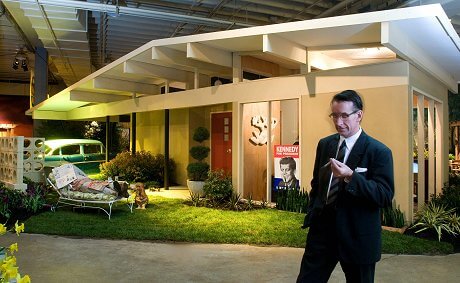 I met Ted Cleary of Ted Clearly Landscape Architecture when we both spoke at the Charlotte home show — that’s him, playing up his mad men persona, in front of the mini-Eichler he designed, installed and landscaped for the event. He and I got along famously, in fact, we were kind of a Friday night double feature: Mid-century homes inside… and out. I’ll tell you: I learned a lot about landscaping mid century modern homes, in just one hour of listening to Ted.
I met Ted Cleary of Ted Clearly Landscape Architecture when we both spoke at the Charlotte home show — that’s him, playing up his mad men persona, in front of the mini-Eichler he designed, installed and landscaped for the event. He and I got along famously, in fact, we were kind of a Friday night double feature: Mid-century homes inside… and out. I’ll tell you: I learned a lot about landscaping mid century modern homes, in just one hour of listening to Ted.
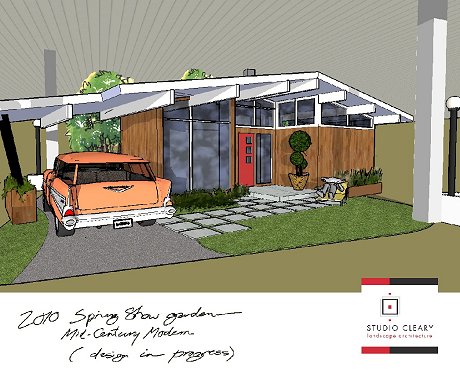
Ted writes:
Can you start by telling us about yourself and your background in landscape design?
I’m a sole practitioner, designing and managing the construction of landscape projects for a mostly-residential clientele. After Clemson University’s five-year LA program, I followed the path of most young graduates and went to work at conventional landscape architectural firms, whose focus is typically on larger commercial projects. While these provide great experience in such technical issues as drainage and construction detailing, the reality is that the bread & butter work of most firms are conventional shopping centers and office parks and the like, where the developer is motivated to follow only the most basic landscaping requirements, rather than the sorts of cutting-edge high design praised in architectural journals. I’ve always maintained that you could train a monkey to sit in front of a computer and stamp tree symbols on a Wal-Mart parking lot plan. I gravitated to garden design, where the “end user” is excited about really making their home their own modest version of paradise, and the opportunities to do it creatively are so much greater.
Why did you get so interested in mid century landscape design?
All across America, we have subdivisions built in the past two to three decades filled with contemporary interpretations of French Chateaux, Arts & Crafts Bungalows, and other period, historic styles. A trait they usually share is that they’re designed with square footage as the driving factor, and often their scale, in relation to each other and to their own outdoor spaces, makes for awkward relationships.
In recent years, I believe the movement toward houses that are bigger on design quality but smaller in size has really developed a following. You can build a new home with this philosophy, but why not look for it in an existing older home with a sense of age and continuity, when there’s so much great post-war housing stock? Our parents’ generation happily raised families in these homes, under more modest conditions of space that fit better with today’s smaller families. While there are indisputable issues to deal with in an older home of energy efficiency and the like, and some interior layout changes are usually in order to make them more livable, I’ll take a cozy older home with real lap siding, true-divided-lite windows, and a lovingly maintained garden hands-down over many of today’s characterless big boxes. But, to complete this picture of domestic bliss, the outside spaces should reflect the style and period. In most cases this landscaping has ‘lost its way’ through the vagaries of time, weather, and changing tastes; I want to see it more reflective of its history.
For this first story, can you tell us, in general, what are the key, foundational elements or drivers of mid-century landscape design. Like… the theory behind it… that residential homeowners should be thinking of?
Well, I think we can look at it in a couple of ways; traditional homes had one ‘look’, but mid-century modern ones quite another. With the latter, a seamless quality between inside and outside was an integral aspect of mid-century modern architecture, and there’s a very recognizable vocabulary of rectilinear patios, clean lines, and bold curving shapes with no focal point or symmetry. Influential landscape architects such as Garrett Eckbo were strongly influenced by the abstract painters of the mid-century.
But as Pam has pointed out, most of these modest post-war homes instead reflected a traditional style, whether we’re talking about a Cape Cod, a neo-Colonial, or a rambler. If you carefully study garden books of the ‘40s and ‘50s, when you scrutinize the black and white or fading color photos, you’ll see that the better landscaping really was not a lot different than what we garden designers today think of as basic, sound design principles: overlapping plant masses, interesting specimens, a sense of ‘movement and rest’, and entertaining areas using hardscaping materials and geometries in sympathy with their house’s style. We could speculate that our parents and grandparents, having weathered a deep, sobering Depression and the full-on sacrifices of a second World War, were looking for the comfort of traditional styles in both their homes and the landscaping that surrounded it, but in a simpler and more affordable version geared toward the middle class. There seemed to be a bit more emphasis on bright circus-like colors with big Dahlias, Hollyhocks and high-maintenance Hybrid Tea Roses, yet designs tended to be a bit more ‘tight’. Today’s trend, by comparison, introduces somewhat relaxed, native perennials and shrubs, which have become more mainstream not just for the aesthetics but the environmental aspects of water conservation and so on, which of course was virtually a non-existent concern back then. One easily-overlooked aspect of mid-century garden design is what’s not included: the sorts of materials like stackable concrete block walls or vinyl fencing that weren’t around back then, and an absence of the over-the-top luxury added to so many expensive backyards in recent pre-Recession times. It’s interesting to me how the influences of Modern design crept into the look of many otherwise-traditional gardens, no doubt because of popular magazines like Sunset, in a similar way to the merchant builders who cobbled together different features they admired into their hybrid home styles.
How about showing us one nice design – and why it’s great.
Mid-century modern garden design is very diverse, even though it has an unmistakable ‘vocabulary’ as I described. But if I had to choose one specific project that’s really iconic for the period, that would have to be the Donnell Garden in northern California. Thomas Church is generally recognized as the first landscape architect to reject his Beaux-Arts training of classical formality, in favor of a Modernist approach that both responded to and defined the “California Style” of relaxed outdoor living. In 1946, Church created a pool area whose genius is in the clean, sweeping curves that echo distant views of rolling hills and San Francisco Bay beyond the rural landscape of their ranch. The Donnell descendants have done a wonderful job maintaining it in its original state, and I think its elegant simplicity is the reason it still draws admirers today to see it, sixty-four years later.
Thank you, Ted!



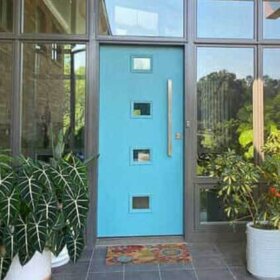
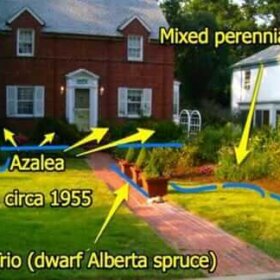

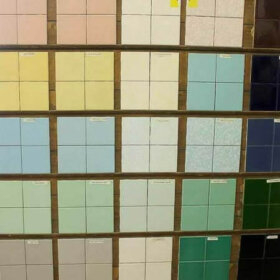
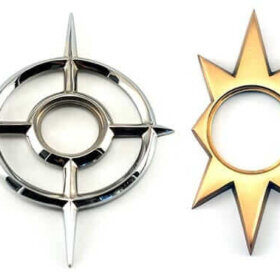

Carol says
Well, we were unable to secure one of those precious mid-century mod homes from yesteryear due to the few left in our part of NC being demolished rather than available for purchase. Instead, we got an original old-school architectural drawn plan for one that was built in 1958 and had it built new with very few changes other than updates per building code. We are on a wooded site, which helps our flow into the outdoors. Any suggestions for landscaping and gardening as we prepare for Spring?
Ted Cleary says
Hello Carol. This is Ted, the author of this article from LONG ago, and I just happened to be re-reading it & the comments section. I also happen to be in North Carolina…..which, as you’d be interested to know, if you don’t already), lays claim to the 3rd largest concentration of MCM homes in America (specifically, in the Triangle area of Raleigh/Durham/Chapel Hill). Unfortunately, for various reasons, the guest-blog series did not continue, but if you wish to reach me through Pam & she agrees, she can put you in touch. Enjoy your new/”old” home; sounds wonderful!
Lorie says
I wish this had continued too! Any way we can talk Ted into doing the next article? I have so many questions about landscaping for a modest MCM two story in Texas. I am in need of native drought loving plants that thrive in clay soil.
Stephen Heller says
I wish that this had continued. What would be a period correct retaining wall for a 50’s home?